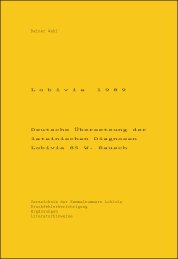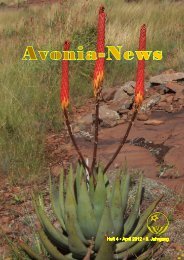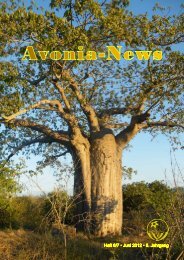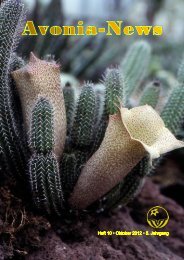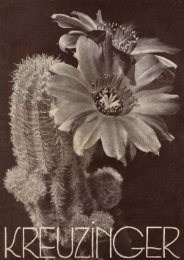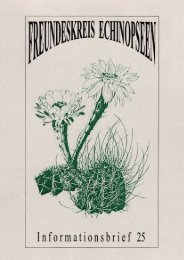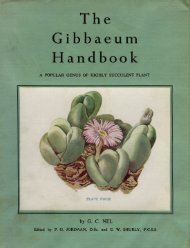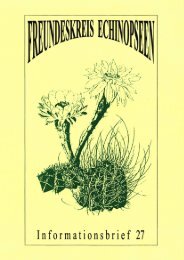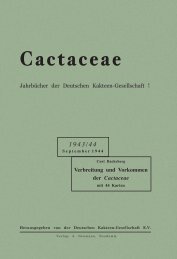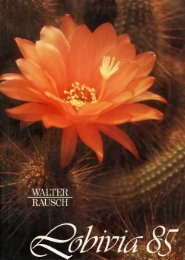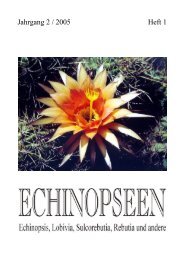Lithops - Au Cactus Francophone
Lithops - Au Cactus Francophone
Lithops - Au Cactus Francophone
You also want an ePaper? Increase the reach of your titles
YUMPU automatically turns print PDFs into web optimized ePapers that Google loves.
✱<strong>Lithops</strong> Brevis. Folia subaequalia, ad 3.2 cm. longa, parte libera brevi, 5–6<br />
mm. longa, apice per 5 mm. divergente, 1.5–1.6 cm. lata, apice ad 1 cm. diam.,<br />
superne brunneo glauca vel in cultis glauca, pallide roseata suffusa, fenestra<br />
bene visa, sat parva, sordide olivaceo viridi, saepius enotata, margine exteriore<br />
integra vel inconspicue diviso; flores pomeridiani vespertinique; pedunculus<br />
inclusus, ad 1.8 cm. longus; receptaculum ca 3 mm. longum, ad 6 mm. diam.;<br />
sepala 5, brevia 5–6 mm. longa, basi 2–5 mm. lata; petala 1–2 seriata obtusa,<br />
inferne attenuata, aurea, 7–8 mm., vel in flore altero L 1.1–1.2 cm. longa,<br />
ad 2 mm., vel rarius ad 25 mm. lata; filamenta lutea, superne aurea, ad 6<br />
mm. longa, antheris luteis; ovarium supra planum, lobis vix visis; stigmata 5,<br />
6–7 mm. longa; capsula senectissima tantum visa, supra fere plana.<br />
Namaqualand: “Hills 5 miles S.E. of Viool’s Drift,” Orange River, Oct.<br />
183, Pillans, 6608. Fl. Maio Jun. 1932. L. olivacea, L. Bol., valde affinis,<br />
fortasse varietas mera.<br />
4. LITHOPS BROMFIELDII<br />
<strong>Lithops</strong> Bromfieldii. (Plate 5.) Growths solitary or forming clumps of two<br />
or more; window irregular, very dark olive green, and on this a number of<br />
bifurcated blood red to dark brown red lines, the forks ending in the si<br />
nuses of the outer margin; outer margin lobed or laciniated, the lobes or<br />
laciniae projecting into the window and forming ridges or islands; islands and<br />
lobes bullate, coloured a brown yellow; margin coloured light brown yellow.<br />
Flowers yellow.<br />
Keimoes, Gordonia.<br />
This species is easily recognised by (1) the bullate yellow brown mark<br />
ings of the dark green window, and (2) the many dark to blood red lines.<br />
It is related to L. insularis, which grows in the immediate neighbour hood<br />
of this species, but L. Bromf ieldii differs from L. insularis in that there are<br />
no yellow brown markings in the window. In my own mind, however, I am<br />
not so sure that L. insularis is not a variant form of L. Bromf ieldii and<br />
that it stands at the one end of the breadth of variation of L. Bromf ieldii<br />
and that L. Bromf ieldii, as described by L. Bolus, is at the other end. This<br />
can only be settled by an examination of these two species in their natural<br />
habitat (Fig. 19).<br />
<strong>Lithops</strong> Bromfieldii. (Plaat 5.) Planteliggaam enkel of 2 of meer in ’n klomp,<br />
venster onreëlmatig, baie donker olyfgroen en in hierdie deursigtige deel ’n<br />
aantal gevurkte bloedrooi tot donker bruinrooi lyne, die vurke eindig in die<br />
inhamme van die buitenste soom; buitenste soom geslip; sommige van die<br />
slippe vorm uitlopers in die venster in en vorm eilande; die eilande en die<br />
slippe opgeblaas, geelbruin; op die eilande ’n groot aantal klein wit stippeltjies;<br />
binnesoom byna reguit; eilande en some lig bruingeel gekleurd. Blomme geel.<br />
Keimoes, Gordonia.<br />
59



